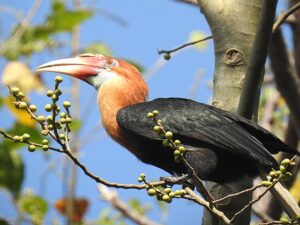Biodiversity is crucial to the existence of life in its current form on earth. However, with increasing human imposition and interference in earth’s reserves and processes, several species of flora and fauna are pushed to the verge of extinction. In fact, biologists have estimated that species extinctions are currently 500–1000 times the rate seen in the history of the planet.
International Day for Biological Diversity is observed on 22nd May each year to increase understanding and awareness regarding biodiversity issues. Let us utilise this day to understand what are biodiversity hotspots, identify the biodiversity hotspots in India, and the measures required to protect them.
What are Biodiversity Hotspots?
Biodiversity Hotspots are regions that are a prime location for the existence of rich biodiversity but face the threat of destruction. As defined by Conservational International, To qualify as a biodiversity hotspot, a region must meet two strict criteria:
It must have at least 1,500 vascular plants as endemics — which is to say, it must have a high percentage of plant life found nowhere else on the planet. A hotspot, in other words, is irreplaceable.
It must have 30% or less of its original natural vegetation. In other words, it must be threatened.
Biodiversity Hotspots in India
India is blessed with rich biodiversity because of its diverse topography. The country is in tropics receives sufficient sunlight to support an optimum temperature which helps various species thrive. Indians have traditionally respected the biodiversity and worked towards its protection and conservation.
The scenario has changed over time because of the rising needs of the increasing population. In securing the economic security of people, the preservation of biodiversity has taken a back seat in the list of priorities of Indians. This has given rise to four biodiversity hotspots in India. These are:
The Western Ghats
The Western Ghats form the coastline on the western edge of peninsular India. These mountains are responsible for the southwest monsoons in the country. The Western Ghats contains more than 30 per cent of all plant, fish, herpetofauna, bird, and mammal species found in India. In addition to this, the mountains also house a large number of species that are endemic only to the said region. A total of 58 protected areas consisting of 14 National Parks (NP) and 44 Wildlife Sanctuaries (WLS) fall within the boundaries of the Western Ghats.
Biodiversity in the Western Ghats is threatened by a variety of human pressures. Of the approximately 180,000-square-kilometer area in the Western Ghats region, only one-third is under natural vegetation. Moreover, the existing forests are highly fragmented and facing the prospect of increasing degradation. Expanding human populations, poor governance and a host of macro-economic development policies are only contributing to further degradation.
In order to preserve this precious region, conservation efforts need to be strengthened. For this, a new approach that facilitates partnerships between government and civil society organizations, as well as corporates, is required. Among many organisations focusing their energy into the preservation of Western Ghats is Daikin India.
Daikin India has launched a CSR project called ‘Forest for the Air’ which aims to achieve long-term protection of the community-owned forests in the north part of the Western Ghats. It includes community-centred planning and implementation of forest protection activities, reforestation using native tree species, local business development such as medicinal plant harvesting, the introduction of more efficiently burning furnaces, and surveys related to ecosystem services.
The Himalayas
This region comprises of Bhutan, Northeast India, and Southern, Central and Eastern Nepal. There are almost 163 endangered species in this region including one-horned rhinoceros, wild Asian water buffalo and as many as 45 mammals, 50 birds, 12 amphibians, 17 reptiles, 3 invertebrate and 36 plant species. There are many species such as Red Panda and Pygmy Hog which are endemic to this area.

There are more than 70 formally protected areas in the seven northeastern Indian states within the Eastern Himalayas region, covering more than 15,000 square kilometres. Two of these, Manas Tiger Reserve and Kaziranga National Park in Assam, have been declared World Heritage sites.

Tata Housing has directed its CSR efforts in conservation of these areas. The Company has partnered with WWF-India to work towards biodiversity conservation in western Arunachal Pradesh and Sikkim and tiger conservation in six tiger landscapes of India. The company has launched a long-term initiative called ‘Greening young minds through Environment Education’. Under this initiative, Tata Housing in partnership with WWF-India is creating environmental awareness among school children, school teachers and communities through posters, booklets, notebooks and workshops etc. highlighting the environmental sensitivities of the region.
Indo-Burma Region
This region consists of numerous countries including North-Eastern India (to the south of the Brahmaputra River), Myanmar, and China’s Yunnan provinces southern part, Lao People’s Democratic Republic, Vietnam, Cambodia, and Thailand. It is spread over a distance of 2 million square kilometres.
Sundaland
This region mainly consists of South East Asian countries including Thailand, Singapore, Malaysia, Brunei, and Indonesia. However, India’s Andaman and Nicobar Islands also fall in this region. Andaman and Nicobar islands were declared as the world biosphere reserve in 2013 by the United Nations. These islands have a rich terrestrial as well as marine ecosystem including mangroves, seagrass beds, and coral reefs. There are over 1067 species that are endemic to these islands. Some of these endemic species include Narcondam hornbill, Nicobar megapode, Nicobar treeshrew, among others. The islands are home to more than 10 per cent of the country’s fauna species in the area that is 0.25 per cent of the total landmass of India.


